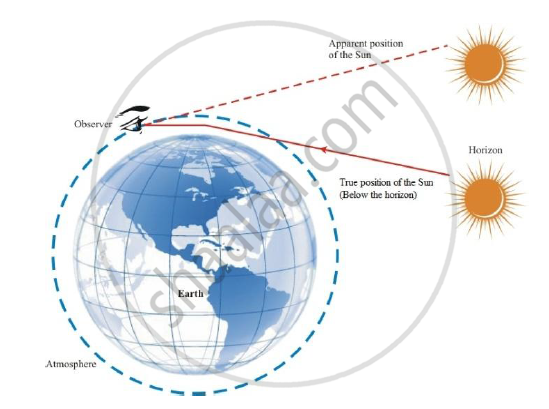Advertisements
Advertisements
प्रश्न
What is atmospheric refraction? Use this phenomenon to explain the following natural events:
Advanced sun-rise and delayed sun-set.
Draw diagrams to illustrate your answers.
उत्तर
The sunrise is advanced because of the atmospheric refraction of sunlight. An observer on the Earth sees the Sun two minutes before the Sun reaches the horizon. A ray of sunlight entering the Earth's atmosphere follows a curved path because of atmospheric refraction before reaching the Earth. This happens because of a gradual variation in the refractive index of the atmosphere. For an observer on the Earth, the apparent position of the Sun is slightly higher than the actual position. Hence, the Sun is seen before it reaches the horizon.

The increased atmospheric refraction of sunlight occurs also at sunset. In this case, the observer on the Earth continues to see the setting Sun for two minutes after the Sun has dipped below the horizon, thus delaying the sunset. The advanced sunrise and delayed sunset increase the duration of the day by four minutes.
APPEARS IN
संबंधित प्रश्न
The phenomenon that causes the twinkling of stars is refraction of light.
Name two effects produced by the atmospheric refraction.
Atmospheric refraction causes advance sunrise and delayed sunset. By how much time is:
sunset delayed?
Why do stars seem higher than they actually are? Illustrate your answer with the help of a diagram.
The atmospheric refraction of light causes the twinkling of:
(a) planets only
(b) stars only
(c) planets and stars
(d) stars and satellites
Due to atmospheric refraction of sunlight, the time from sunrise to sunset is lengthened by about:
(a) 6 minutes
(b) 2 minutes
(c) 4 minutes
(d) 5 minutes
A star sometimes appears brighter and some other times fainter. What is this effect called? State the reason for this effect.
Explain why the planets do not twinkle but the stars twinkle.
Refraction of light by the earth’s atmosphere due to variation in air density is called ____________.
How does refraction take place in the atmosphere? Why do stars twinkle but not the planets?
